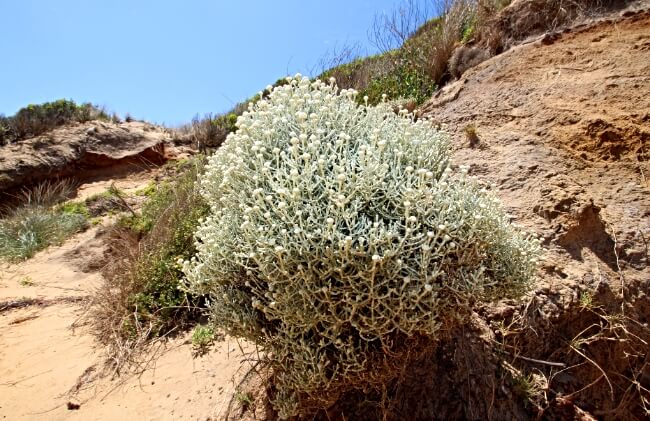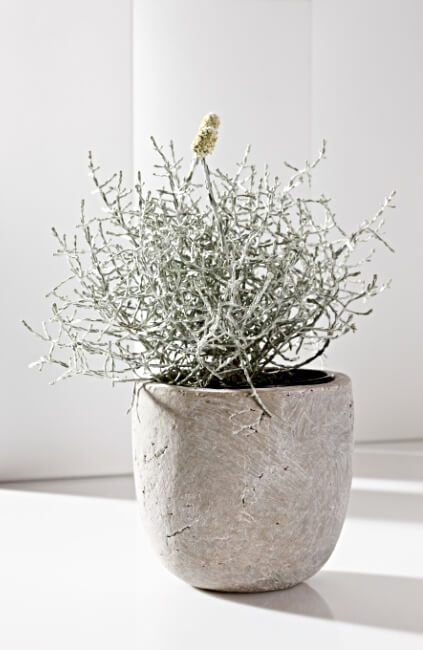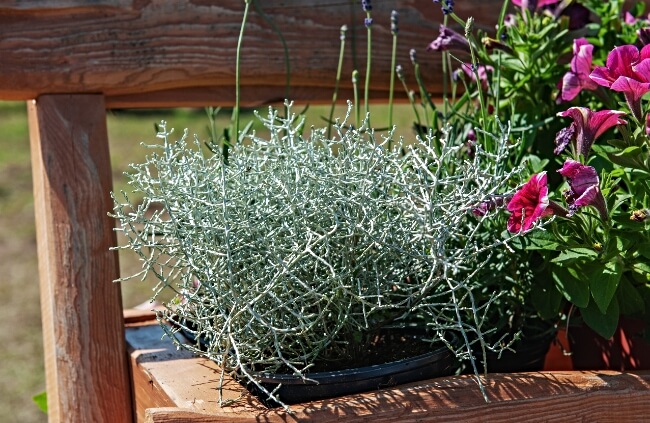The charming and beguiling cushion bush makes for a wonderful addition to an Australian native garden. Leucophyta brownii is the sole species in this genus and it’s packed with character.
Known as the cushion bush, among other names, its tight bright flowers are held on longer stems above the shrub, with a distinct pin cushion form, topped with bountiful pins during flowering.
I adore this native shrub and believe it should grace every garden possible, so below, I’ll outline the best possible conditions for growing a cushion bush and how this Australian native will reward you with cheerful flowers the bees will adore.
More...

Family: | Asteraceae |
|---|---|
Genus: | Leucophyta |
Species: | L. brownii |
Common names: | Cushion Bush, Silver Wire Bush, Australian Garland Flower, Wire Netting Bush, Coastal Daisy Bush, Brown’s Cushion |
Origin: | Australian native |
Location: | Outdoor |
Type: | Small shrub, herbaceous |
Growth: | 1.2m height and width |
Sun requirements: | Full sun / part shade |
Foliage colour: | Silver |
Flower colour: | Yellow or white |
Flowering: | Summer |
Edible parts: | None |
Maintenance level: | Low |
Poisonous for pets: | Not toxic, but can cause mild stomach upsets |
What is a Cushion Bush?
Leucophyta brownii, formerly known as Calocephalus brownii, is a small and attractively rounded shrub with a robust personality. The cushion bush is native to the southern coast of Australia so it can tolerate salty air, poor soil and dry conditions.
It not only survives but thrives in the harshest environments where drought, arid and infertile soil will only allow survival of the fittest.
Commonly known as silver bush, wire netting bush and cushion bush due to its striking silver foliage and dense low growing form. This silver fox of the shrub world is mostly grown for its foliage but its small pale yellow flowers will help attract all those crucial native pollinators to your space.
Identifying Leucophyta brownii
Reaching only a diminutive 1 metre in height, the cushion bush is recognised by its unmistakable foliage and rounded cushion shape. Lined with woolly hairs to reflect light, Leucophyta gains a silvery appearance to its stems and leaves almost resembling a silver tumbleweed.
Adapting to dry and bright conditions, the cushion bush’s leaves are tiny and scale-like sitting close to the stem, giving the bush a skeletal silhouette. Then forming silver, button-like rounded flower heads that open to pale yellow flowers from late spring through summer.
Cushion Bush Natural Habitat
Leucophyta brownii grows along coastland, cliffs and dry dunes where conditions can be extreme. They are known to be resilient against harsh winds, salt spray, prolonged drought and frost.
Cushion bush has successfully colonised areas in the South Australian coastal mainland, northern Tasmania, King Island and Flinders Island. They tend to flourish best in sunnier climates where humidity is low and soil tends to be impoverished.
Common Uses of Cushion Bush
The cushion bush is an evergreen or ever-silver perennial much loved by ornamental and sustainable gardeners alike. Its highly decorative form is often used as border edging, absorbing moonlight to help guide your way around at night.
If you’re looking for an unusual hedge then the cushion bush may be the one for you. With no pruning required its low-growing form can make for a beautifully dense native hedge. Leucophyta brownii is a perfect contrast plant as it compliments neighbouring plants beautifully, especially those with darker, richer foliage like Heuchera.
Another brilliant use for Leucophyta draws on its ability to stabilise soil structures with its dense root system. Preferring to grow on the loose, free-draining ground, the cushion bush can stop wind erosion and, literally, hold its ground.
With their ability to tolerate hard conditions, cushion bush shrubs are perfectly suited to water-wise gardens, hanging baskets, rockeries and crevice space filling. They even make for an intriguing addition to cut flower displays as foliage interest and structure.


Get Your Free Guide:
Master Growing Australian Natives eBook
A Must Have Complete Guide for Every Australian Garden
Get Your Free Guide:
Master Growing Australian Natives eBook
A Must Have Complete Guide for Every Australian Garden
Popular Cushion Bush Varieties
1. Leucophyta brownii ‘Challenge’
Leacupytha brownii ‘Challenge’ is perhaps the most similar garden cultivar to its native parent, but with flowers that are crisper, and paler. Personally, I much prefer the yellow pops of the native cushion bush, but there are many gardeners who abhor yellow and aim for white in all their designs.
If you’re one of them, then this is definitely the shrub for you. It’s virtually un-killable, and thrives on neglect, with rewards of elegant foliage and flowers from late spring through to mid-summer.
2. Leucophyta brownii ‘Moonshine’
Leucophyta brownii ‘Moonshine’ is a large cultivar of the common cushion bush, with an ultimate spread of 140cm. They will grow just as well indoors as outdoors as, despite their size, they are very slow growing, and take almost a decade to reach their full size.
What really sets ‘Moonshine’ apart from other garden cultivars is its colour. It is still distinctly glaucous, but with a subtle blue, turquoise, hint to its foliage that contrasts spectacularly against other shrubs.
3. Leucophyta brownii ‘Silver Nugget’
Also called Leucophyta brownii nana ‘Silver Nugget’ or Leucophyta brownii Nana by different nurseries, this is the smallest cultivar available, growing to just 3cm across and 30cm tall.
It makes exceptionally useful border edging, as a low-growing hedge, or can be used to great effect in pots and containers as a filler plant, with more dramatic colourful bedding planted in and around it.
4. Leucophyta brownii ‘Silver Sands’
Leucophyta brownii ‘Silver Sands’ is an incredibly dense shrub, growing to about 60cm tall, and with a longer lifespan than most cultivars, averaging ten years in most gardens.
Its dense, doming-habit is similar to the naturally occurring cushion bush, but with shorter flowering stems, and a far more formal finish.
How to Grow Cushion Bush
Cushion bush couldn’t be simpler to grow as it needs very little care and attention. Follow these outlines when planting or propagating your cushion bush for the healthiest, strongest specimen.

How to Propagate Cushion Bush
Making new Leucophyta plants can be a very cost-effective way of creating more plant stock, especially if you are growing your own hedging. Propagation is particularly reliable via cuttings and commercial plants are mostly produced this way. However, they can also be grown from seed.
Propagation of cushion bush is useful to know as plants can often be short-lived, so having regular replacement plants to replace old stock can provide healthy replacements and continuation of this native favourite.
Propagating Cushion Bush from Seeds
Seed propagation is also known to be fairly successful for cushion bush, but not as reliable as cuttings. To sow cushion bush from seed, simply sprinkle the seeds sparingly onto the surface of a well-drained and gritty potting mix.
Do not cover the seeds, and water the tray from the bottom so the moist soil sucks the seeds down into full contact. Place the seed tray or pot in a bright, sunny spot. Seedlings should appear within 2-4 weeks after sowing.
Cushion Bush Propagation from Cuttings
Cuttings are known to be the most successful way to create new Leucophyta plants. Cuttings should be taken from semi-hardened wood and pushed into a gritty, sandy medium.
Caution should be taken not to over-water cuttings in general, but this is especially important for cushion bush cuttings. Once cut and inserted into a cutting mix, water them once, and then leave them somewhere warm and shaded, watering only when the potting mix dries up.
Cushion bush cuttings root quickly, often within a week, and should be ready to pot up or plant out after a couple of months.
Ideal Conditions for Growing Cushion Bush
When finding the best position for a cushion bush, it’s important to remember its natural habitat. They grow in hostile environments where water and accessible nutrients are in short supply.
In our domestic gardens, they are more likely to be killed from kindness; with over watering and feeding. To avoid this there are some requirements to consider for a healthy Leucophyta.

Soil & Drainage
The cushion bush wants to spread its roots through sandy, loamy soil. Its preference would be for a well-draining and gritty substrate that allows water to drain away. Avoid anything that will hold onto moisture such as clay.
Alkaline to neutral soil is beneficial, but not essential. Using compost full of nutrients would be a waste as they thrive in poor infertile conditions. Growing your cushion bush in a container or pot can provide the right controlled environment for it to thrive.
Light & Temperature
Although the cushion bush resembles the snow-covered bare skeleton of a leafless bush in winter, Leucophyta isn’t tolerant of colder conditions. They are only hardy down to around -5°C, so it’s important to protect your cushion bush over winter if situated in a colder location.
Cushion bush grows best in full to part sun and won’t thrive in a very shaded corner. Their leaves and stalks have adapted to bright light so they can handle the sunniest spot.
Shelter
Sheltering your cushion bush from harsh weather isn’t an issue with these tough and tolerant plants. However, if growing in a pot, it may be wise to move it to a dry spot, or a covered location in overly wet weather.
As above, fleece protection during any especially cold weather is useful for young plants.
Planting Cushion Bush
The key to planting a Cushion Bush is to add as much drainage to the planting hole as possible. This can be in the form of sand, grit or even building rubble as this can create good alkaline soil with excellent drainage.
With all plants, once newly planted in its location, a good watering-in will help its roots establish alongside a subsequent watering in dry spells whilst establishing. When considering a planting location, if you aren’t able to provide good drainage in the ground, plant your Leucophyta into a container instead.
Container-grown cushion bush will allow for more natural drainage as well as offering growers in colder parts of the country to move them into protected spaces during cold and wet winters.
Cushion Bush Care
Overall, caring for Leucophyta brownii requires little to no effort. They need no extra watering or feeding, and too much attention is likely to have a negative effect. Cushion bushes are a perfect plant for those gardeners that take a laid-back approach to tending to plants.
Pruning Cushion Bush
Pruning cushion bush isn’t really necessary as it will form its own rounded shape without any intervention. However, if growing a hedge, light pruning to care for dead, damaged or diseased material is wise.

Common Problems When Growing Cushion Bush
Cushion bush is generally very tolerant of most conditions. However, problems can occur when the plant is subjected to improper conditions like humidity and overwatering.
This can lead to common fungal issues that are often hard to spot in their early stages, thanks to the fine leaves, but even this is rare as pest damage is virtually non-existent with these tough, distasteful shrubs.
Luckily, Leucophyta brownii doesn’t suffer from any pest problems. They don’t have the thick, juicy foliage that insects like to munch on, and are seemingly deer and mammal-resistant.
That makes them a great but unusual alternative to traditional hedging, as they are virtually bullet-proof, and offer pest-proof, evergreen structure.
Grey mould (Botrytis) can be a problem if your cushion bush is in an overly humid environment. Without proper drainage and ventilation, the plant will develop areas of rot and grey fuzzy patches of mould.
Crown rot and root rot will occur in similar situations, but as long as you follow the planting guide above, and maintain good drainage around your plants, these sorts of issues are rare.
If you do notice any fungal issues above ground, simply cut the infected sections of the plant out, and by late spring the following year these resilient shrubs will easily fill out the empty space and return to their nest-domed structures.
Cushion Bush Frequently Asked Questions
How do you look after Leucophyta?
Drainage, drainage, drainage. The key to success in caring for Leucophyta is drainage. Plant them in full sun, on an exposed site, with poor, well-drained soil, and leave them to it.
Is Leucophyta frost hardy?
Leucophyta is frost hardy down to -5°C, but will not survive prolonged frosts, and young plants should never be left out in temperatures near freezing without fleece protection or some form of insulation.
Is cushion bush perennial?
Cushion bush (Leucophyta brownii) is a perennial shrub, but famously short-lived. They generally live for about ten years in gardens, but often as short as five years.
What colour are the flowers of Leucophyta brownii?
The flowers of Leucophyta brownii are yellow, but as they develop they have a gorgeous white bud, which adds just as much interest as the flowers that later develop. Even once faded, the flowers and stalks add structure to your garden.
How do you feed Leucophyta brownii?
Leucophyta brownii do not need feeding. It thrives on poor soil with minimal nutrients and is more at risk of harm from overfeeding.
How often should you water a cushion plant?
After planting, water your cushion plant generously, and then allow the soil to dry out. Water again when the soil dries out for the first summer after planting a cushion bush, and then leave it be. In their second year and beyond, cushion bush requires no irrigation.
Transform Your Garden with the Coastal Charm of Cushion Bush
Although the Cushion Bush may be short-lived, there are so many reasons to have one in your garden. If you only have limited space, this compact, frosted bun-shaped bush will be a stand-out specimen, drawing your eye straight to it as its flowers and foliage glow brightly against other shrubs and herbaceous planting.
Those who tend to have less than green thumbs can relish in the effortless care requirements the cushion bush needs. For those who like to potter and propagate, Leucophyta will serve you well, giving you the potential for hours of enjoyment. The comforting cushion bush is one of a kind, in species and in character.
Published on June 4, 2025 by Nathan Schwartz
Last Updated on January 21, 2025




